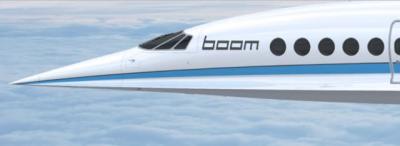Dreamt of having a lunch meeting in Paris and getting back to New York City in time to tuck the kids into bed? That’s what Joshua Krall of Boom Technology says his supersonic commercial jet will be able to do for you. Krall is revealing this dream at the first-ever Rescale Night in the United States.
It was a sad day in 2003 when the Concorde was grounded, cancelling the chance of supersonic flight for all civilians. The Concorde, with its sleek shape and massive jets, was easily the sexiest commercial jet ever. It made every other passenger jet look slow and dumpy. But its fuel guzzling proved to be too much for the airlines that flew it. Tickets higher than $10,000 (that was 40 years ago) were not enough to turn a profit.
The Boom SST, currently available only as a 3D CAD model, is a smaller, lighter and more modern Concorde. It will probably have Wi-Fi.
The entire company is smaller than a single division of Boeing or Airbus. “We have 25 people,” said Krall. “But almost all of them are engineers ... and we are growing.” Boom has landed a $2.1 million round of funding. A letter of intent by Virgin to buy 10 SSTs should lead to more funding. The company is now able to add to its Denver-based staff and expand facilities. We see the Boom’s servers next to a toilet. “It was the only room we had,” laughed Krall.I am reminded of how, from humble beginnings, William Boeing started his airplane company with only one engineer, the legendary Wong Tsu of China.
The Boom SST will fly at Mach 2.2, a bit faster than the Concorde. At a top speed of 1,450 mph, you will get from New York City to Paris in 3 hours and 15 minutes. And it will be cheaper. Boom projects you can get onboard with a $2,500 business class ticket.
How Now?Boom cites three reasons why its plane will be the new success of supersonic commercial flight:
- Fuel efficiency. Jet engines have made a few improvements since the days of the Concorde.
- Better aerodynamics. The Boom shares the air-piercing look of the Concorde. Boomers are spending a lot of time tweaking the design, and subtle changes have led to aerodynamic improvements. Boom makes heavy use of computational fluid dynamics (CFD) simulation, which allows for rapid consideration of design changes.
- Less weight. Boom employs widespread-use of carbon fiber composites.
Boom is joined in the quest for a supersonic civilian flight by Spike, whose S-512 will fly at Mach 1.6.
NASA has also been flying an SST demonstrator, the QueSST, which flies at Mach 1.4.
RescaleDoing hundreds of CFD analyses a day doesn’t come cheap. Unlike NASA, a small company like Boom cannot be expected to own supercomputers. (There may not be enough space in the men's room.) Instead, Boom makes use of computers via Rescale, another startup, which lets Boom run CFD on hundreds of cores on high performance computers, just like the big boys. Being able to rent hardware this way alleviates small companies from large capital expenditures and allows them to use their funding to get the brains on the job. Boom brags about its dream team, all of them industry vets, engineers and builders.
Rescale lists hundreds of software titles, including engineering software like ANSYS Fluent, CD-adapco’s STAR-CCM+ and COMSOL for CFD. All are based on pay per use, so there are no upfront license costs.
Having access to supercomputing is a concept that seems to be catching on, if only judging by the amount of investment that software as a service (SaaS) is receiving. Rescale has received over $20 million in funding, with $14 million of it in May 2016.
Rescale competes with SIMSCALE, which also offers engineering software on a SaaS model.
| An engineering.com release | February 14, 2017 ||
